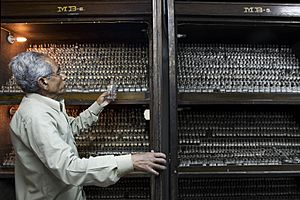Homeopathy facts for kids

Homeopathy is a type of alternative medicine. It was started in the 1700s by a doctor named Samuel Hahnemann. The main idea behind homeopathy is that a sick person can get better by taking a very tiny amount of something. This "something" would cause the same symptoms of the illness in a healthy person.
Scientists have studied homeopathy a lot. They have found that it does not actually work to cure diseases. When people feel better after taking homeopathic remedies, it is often because of the placebo effect. This means they feel better simply because they believe the treatment will work, not because of the remedy itself.
Contents
How Homeopathic Remedies Are Made
Homeopathic remedies are made in a very special way. First, a small amount of an ingredient is mixed with water or alcohol. Then, this mixture is shaken very well. This shaking is called "succussion."
After shaking, a tiny drop of this mixture is taken out. The rest is thrown away. Then, more water or alcohol is added to the single drop. This new mixture is shaken again. This process of diluting (making weaker) and shaking is repeated many, many times. It can be done 30 times or even up to 200 times!
Understanding Dilution
This process is called "potentisation" by homeopaths. Samuel Hahnemann believed it would make the "spirit-like medicinal powers" stronger. However, after so many dilutions, there are usually no atoms or molecules of the original substance left in the final remedy.
Homeopaths believe that the water somehow "remembers" the original substance. But Science tells us that this idea goes against the basic rules of physics and chemistry. Water does not have a memory in this way.
Why Homeopathy Became Popular
Homeopathy became popular a long time ago, in the 18th century. Back then, regular medicine was not very good. Sometimes, the treatments doctors used could even make people sicker. For example, doctors might have used harsh chemicals or painful methods.
Because of this, taking homeopathic remedies, which were very diluted, was often safer than traditional medicine. It kept people from getting hurt by the bad medical practices of the time.
Modern Medicine vs. Homeopathy
Today, medicine has improved a lot. Doctors now have many safe and effective ways to treat illnesses. We have antibiotics to fight infections and vaccines to prevent dangerous diseases.
Some homeopaths have told their patients not to use these proven medicines. This can be very risky. It is important to remember that modern medicine is based on scientific research and has been shown to work.
Images for kids
-
Samuel Hahnemann Monument, Washington, D.C., with the inscription Similia Similibus Curentur – "Like cures Like"
-
A homeopathic preparation made from marsh tea: the "15C" dilution shown here means the original solution was diluted to 1/1030 of its original strength.
-
Homeopathic medicines at a store in West Bengal, India.
-
Homeopathic cures for small animals on the Isle of Man
See also
 In Spanish: Homeopatía para niños
In Spanish: Homeopatía para niños




